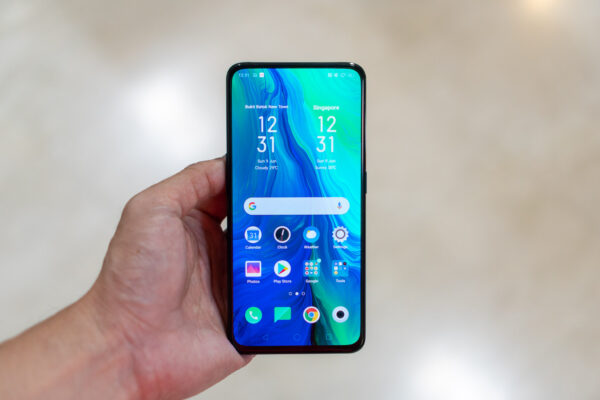
OPPO always tries to be on the cutting edge. For their latest Reno smartphone, they have a new solution for their all-screen notch-less display design. They still have a selfie camera, but instead of a straight pop-up mechanism, it slides out at an angle like a shark’s fin.
There are two Reno smartphones. The more premium one, with a slightly larger screen, has 10x zoom, and aptly named the Reno 10x Zoom. The other, which I have for this review, is simply named Reno. The two are largely the same, except for a different rear camera configuration.
Despite several high-end specifications, the OPPO Reno is positioned as a mid-range smartphone. It’s 6.4-inch AMOLED display is beautiful, especially considering the edge-to-edge expanse is uninterrupted by any notch or hole-punch. The AMOLED display has a resolution of 1080×2340 pixels, giving it a aspect ratio of 19.5:9, and pixel density of 402 ppi. The glass over this display is Corning Gorilla Glass 6.
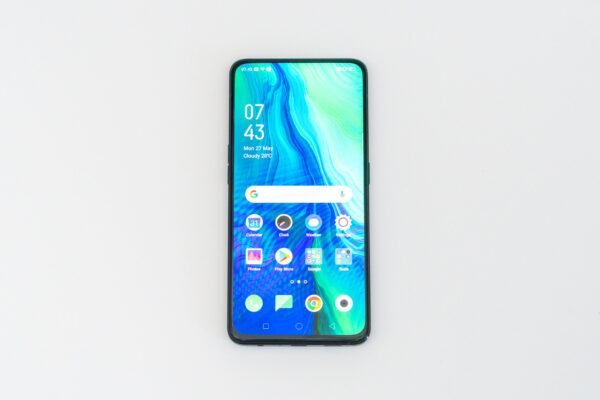
With body dimensions measuring 156.6 x 74.3 x 9 mm and weighing 185 grams, the OPPO Reno feels a little hefty. The 9 mm thickness might seem a little much on paper, but I don’t find it to be all that noticeable.
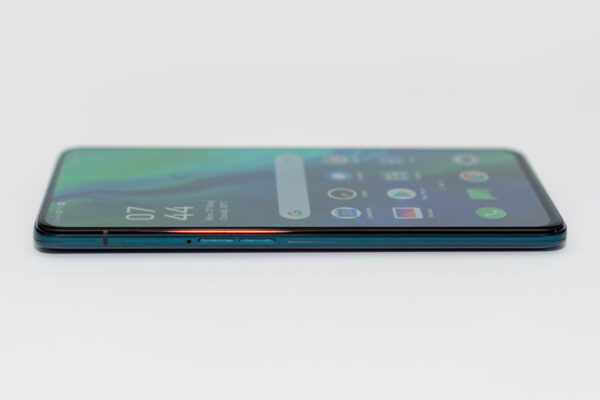
The volume rocker and SIM card tray are located on the left side of the phone. The SIM card tray accommodates two nano-SIM cards, but there is no support for expandable storage.
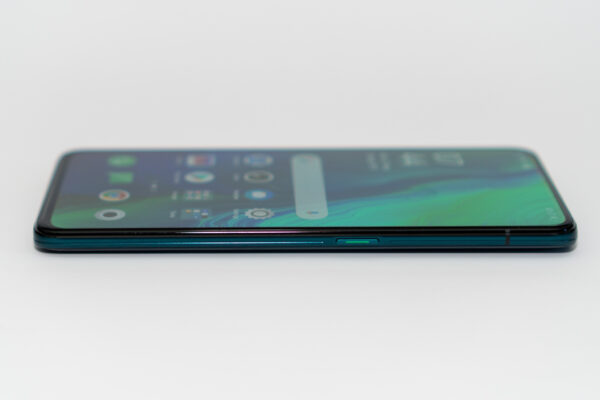
The power button is on the right side of the phone.
At the bottom, you’ll find the USB Type-C port in the middle, flanked by a 3.5 mm audio jack and downward firing speakers. The USB Type-C port supports VOCC 3.0 fast charging.
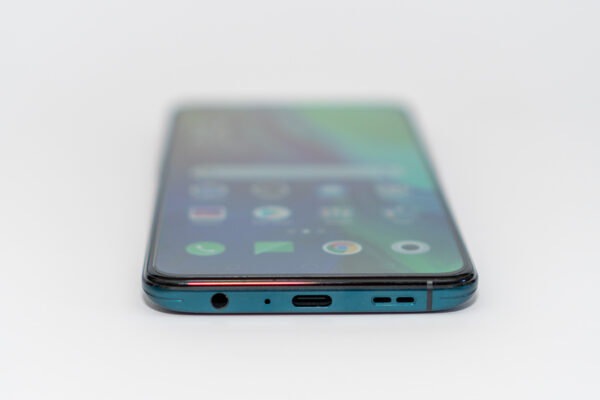
The top of the phone might look rather bare, apart from a visible microphone hole, but then we’re forgetting about the most fascinating design feature of the OPPO Reno. The shark’s fin selfie camera is right there.
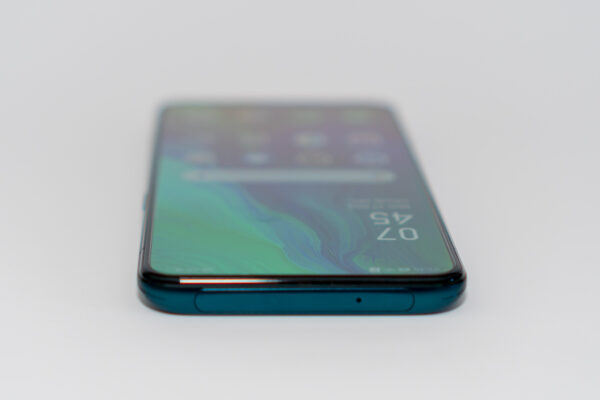
The shark’s fin contraption is a motorised wedge that rises up in 0.8 seconds from the right edge whenever you activate the selfie camera. If you were wary of the flimsiness of straight pop-up camera modules, this wedge appears to be quite sturdy.
OPPO says this shark’s fin mechanism will last for 200,000 actuation. This works out to 109 selfies per day, every day, for five years. You probably won’t take that many selfies a day, let alone keep using the same phone for five years, so it seems like we shouldn’t have to worry about this mechanism failing us.
Furthermore, if the OPPO Reno senses itself falling, the shark’s fin camera will automatically retract. I don’t know if this would be quick enough, but I think, it’s certainly something neat to have.

The front camera has 16 MP, f/2.0, 26 mm (wide) lens that takes good selfie shots. The shark’s fin wedge also houses a flash on the back for use with the rear camera.
There’s a dual camera setup on the back. The main 1/2.0″ sensor is 48 MP, paired with f/1.7, 26mm (wide) lens, with phase detection auto-focus. The second camera is 5 MP, and it is used as a depth sensor. There is no optical image stabilisation.
The camera works quite well. It has a full manual “pro” mode, as well as HDR, beauty, and auto-scene modes. The photos the camera captures are generally good. I find the colours to be a little too saturated, but some others may be happy with the way it is.
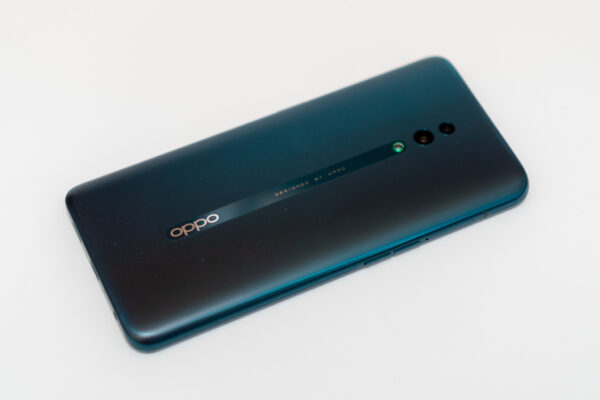
The branding and stripped accent on the back helps to visually distinguish the OPPO Reno from the crowd. That small round stub on the back doesn’t actually serve a real purpose, other than perhaps to offer a bit of grip with your index finger. It is not a fingerprint sensor.
The OPPO Reno offers two biometric authentication methods. The first is via an in-display fingerprint sensor. It works quite well, though not as speedy as a well-implemented rear fingerprint sensor like that on the Pixel smartphones. It also supports facial recognition.
Under the hood, the OPPO Reno is powered by a Qualcomm Snapdragon 710 octa-core processor, with 8 GB of RAM and 256 GB of storage. In terms of performance, the OPPO Reno’s scores on Geekbench 4 are:
- Single-core: 1534
- Multi-core: 5897
- Compute: 6633
On PCMark for Androiid, the OPPPO Reno scored 6578. This, and the Geekbench 4 scores, are similar to other Snapdragon 710 smartphones. This is more than adequate for moderate smartphone use.
For connectivity, the OPPO Reno has LTE (with dual standby) support, 802.11 a/b/g/n/ac dual-band Wi-Fi, Bluetooth 5.0 with aptX HD, NFC, and positioning with GPS/A-GPS, GLONASS, Galileo and BDS.
The OPPO Reno’s battery life is quite awesome. The large 3765 mAh Lithium Polymer battery scored 5260 on Geekbench 4’s battery benchmark, among the best of smartphones I’ve tested. There’s no problem getting more than a day’s worth of use out of this smartphone.
OPPO’s smartphones run the company’s own version of Android, ColorOS. The OPPO Reno ships with ColorOS 6, which is based on the current Android 9.0 Pie, so you get a modern, up-to-date, version of Android on it.
There are two things missing with the OPPO Reno. The first, wireless charging, is perhaps less important. It’s nice to have, but not something that would discourage me from considering the OPPO Reno. The second issue, the lack of any IP rating, is a more serious problem. With IP67 and IP68 becoming increasingly common in many other smartphones, the water-shy OPPO Reno may be a concern for some users.
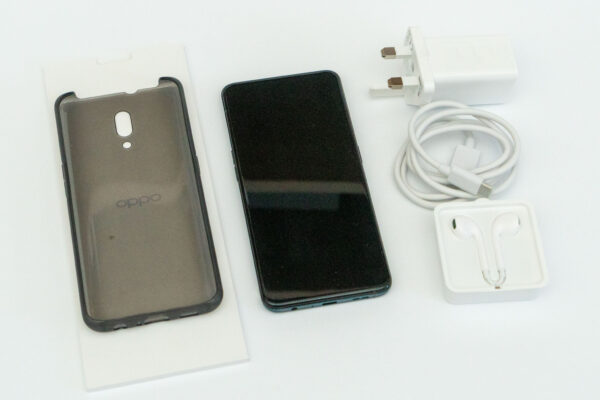
In the box, the OPPO Reno comes with earbuds headphones, a USB Type-C cable, USB wall charger, and a phone case.
The OPPO Reno retails at S$849, and it is available from SingTel, M1, StarHub, and official distributors across Singapore.
Conclusion
OPPO Reno offers a beautiful, all-screen, notch-less display by using a unique, shark’s fin selfie camera mechanism which works very well. At its price point, the OPPO Reno has a lot of features to offer, but not any IP rating.
Pros:
- Unique shark’s fin selfie camera mechanism
- Excellent all-screen notch-less display
- Good overall hardware specifications
- Well-made, robust, body
Cons:
- No IP rating
View Comment Policy